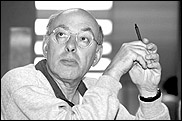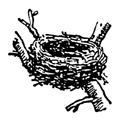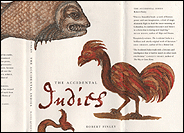on campus
 PHOTO: Owen Egan
PHOTO: Owen Egan |
|
Mintzberg on McGill
Management professor Henry Mintzberg has earned fans the world over with his no-nonsense dissections of corporate decision-making and his withering appraisal of many management fads. Now the celebrated expert on strategy and organization is turning his attention homeward. On October 10, Mintzberg will present a discussion about the choices McGill itself has made over the years.
Entitled "From Small Acorns to Large Oaks: Strategies at McGill University 1829-1980," Mintzberg's talk will focus on the different strategies McGill leaders employed during different eras in terms of funding, student enrolment, faculty matters and buildings.
Organized by the James McGill Society in conjunction with the McGill Associates, the talk begins at 5:30 pm, a half-hour after a brief reception for the event. Mintzberg's presentation will take place in the Faculty Club's ballroom.
Mortgaging your future
 |
|
McGill's Staff Mortgage Loans is one mortgage program that doesn't particularly want your money -- not right now, anyway.
The program was set up in the 1970s when the University was anxious to attract new professors and mortgages weren't as easy to obtain as they are today.
"In the '70s and '80s, you didn't shop around for a mortgage; you took what you could get," notes Louise Savard, treasury officer for staff mortgages. According to Savard, at one point there were almost 500 outstanding staff mortgages with the University; today, that number is 150 and only three were negotiated this past year.
Savard explains that what was attractive about the McGill mortgage plan was the staff discount of interest on the first $65,000; staff members buying a single-family dwelling, for instance, would receive a discount of 15 percent on the interest paid annually, an amount which would be taken off the capital.
Thus a 25-year mortgage could be paid off in as little as 15 years. The McGill mortgage also allows the holder to increase the monthly payments on the anniversary date of the mortgage; any amount exceeding the minimum is applied to the capital, again reducing the numbers of years of payment.
While the discount system still applies, few take advantage of it now, says Savard, because the bank rates and conditions are more attractive overall. "I help them [new employees] figure out where to go. Many professors don't know how mortgages work in Canada," she continues, adding that American employees, who may not have a credit rating here, can get a McGill mortgage while a bank may not consider it.
"We can help new employees figure out how much money they can borrow and still breathe," she continues. "We have a formula which leaves room for a vacation and car payment. People want to know that in the next five years they'll be able to live. They use our mortgage schedules and they shop around."
Savard underlines that the mortgage counselling service is available to all new employees, be they faculty or staff members. She also remarks that, unlike in the past, many new employees choose not to buy a house upon arriving in Montreal; rather, they rent first. The University's Real Estate Office helps employees find rental housing.
Both the Real Estate Office and Staff Mortgage Loans may soon find themselves much busier than they have been during the lean years, given all the hiring of new faculty members which is already underway. And, if mortgage rates begin to climb, "the plan will be more widely used, once again," says Savard.
 |
|
Flight of Fancy
Natural history museums usually display their birds in order to give the viewer some idea of the habitat and habits of the species. But that's not the case of "The Bird Room," an exhibition at the Redpath Museum of cyanotype photos of birds, accompanied by specimen boxes of eggs and a few lone eggs nestled in hollows carved into books or written in the 19th century.
Montreal photographer Loren Williams decided against naming the birds because she wanted to capture their "mysterious, poetic side -- the essential birdiness" rather then their scientific aspect.
Besides, the nature of cyanotype photography doesn't lend itself to great accuracy of representation. A technology dating from the 1840s, cyanotypes involve coating a piece of paper (in the dark) with chemicals, drying the paper and storing it in a dark place until ready for use. The image is created by placing an object on the paper then exposing it to sunlight.
The images of the birds -- which Williams chose both from the Redpath collection and her own -- resemble the shape left when you take away an object found on the floor of a dusty attic. The shape defined by the dust around it is the equivalent of the white shape surrounded by the blue of the chemicals when they are exposed.
Some of the bird shapes are crisp, others ghostlike, still others, mere wisps. The strength of the sun and the wind -- which would cause the birds to move during exposure -- is what determines the definition of the shape, says Williams.
This is a show to visit when in -- or wanting to be in -- a dreamy state, a state in which to ponder the essence of birds. The images are evocative, if a little too close together, as are the accompanying displays. Who knew the many hews and dimensions of eggs?
The Bird Room continues until Nov. 17.
A first in fiction
 |
|
For the first time in its 31 years, the McGill-Queen's University Press has broken with tradition and published a work of fiction.
Not that this was a deliberated decision; rather it was the force of happy circumstance. Islamic studies professor Eric Ormsby, a member of the press's MacLennan Poetry Series selection committee, received a manuscript by fellow poet and poetry editor Michael Harris that wasn't quite poetry and wasn't quite prose.
The author was Robert Finley, an English professor at the Université Sainte-Anne in Pointe-de-l'Eglise, Nova Scotia. The subject: an imagining of Christopher Columbus's maiden voyage to what Finley calls The Accidental Indies, the title of the book.
"It's a fitting title for a meditation on the power of language to create reality," noted Maclean's.
"It's a kind of reverie, something that doesn't fit neatly into a particular genre," said Ormsby, adding that he and everyone else on the poetry committee felt the press should publish it.
Including Philip Cercone, director of MQUP. "It was so damn good that we decided to make it our lead book [in last spring's catalogue] so that it wouldn't get lost in the shuffle," he said.
Not only was the book not lost; it was found by numerous enthusiastic reviewers, including Elaine Kalman Naves in The Gazette, which helped put the book on Maclean's best-sellers list. Already the first 3,000 copies of the book have been sold and the press is on its second run of 4,000, notes Cercone who is investigating selling the rights for publication in the United States to the publishing giant, Viking. At the moment MQUP itself is supplying the U.S. market.
Cercone purposefully put the full-strength of the press's resources behind the 102-page book. The result is a very attractive little volume, designed by David Drummond under the direction of production and design manager Susanne McAdam.
Will the press publish more fiction? Cercone says "Sure, just as long as it's outstanding." And just as long as it comes of its own accord. Now, publishing 100 titles of non-fiction and poetry per year, the MQUP has no time to solicit fiction.
on the move
Ms. Charlotte Cloutier has left her position as director of development for the Faculty of Management to become the executive director of the Fondation de Université de Sherbrooke.
Professor Glenn Cartwright from the Department of Educational and Counselling Psychology, is the new associate dean (information technology and continuing education) for the Faculty of Education. Cartwright studies the educational implications of new technologies.
Ms. Jill Barker is the new fitness coordinator for the Department of Athletics. She will be responsible for the department's Active Living program, which features non-credit physical courses for staff and students. A certified fitness leader and personal trainer, Barker has worked as a fitness instructor and coach with the Lester B. Pearson school board and is a weekly columnist with The Gazette in the area of fitness and recreation.
Mr. Campbell Rolian replaces Ms. Claire Heenan as the Redpath Museum's new science educator. A recent McGill graduate in biology, Rolian has already worked for two summers at the museum under the supervision of Professor Bob Carroll. He will be in charge of organizing the museum's popular Discovery Workshops for children.
Professor Eric Shragge has left the School of Social Work, where he taught for 26 years, in order to assume the directorship of the Diploma Program in Community Economic Development at Concordia University's School of Community and Public Affairs.
Mr. Scot DeJong has returned to Development and Alumni Relations after working for the Muscular Dystrophy Association of Canada. DeJong is the new executive director of development for the Faculty of Medicine.

